ignition CHEVROLET TAHOE 2007 3.G Owners Manual
[x] Cancel search | Manufacturer: CHEVROLET, Model Year: 2007, Model line: TAHOE, Model: CHEVROLET TAHOE 2007 3.GPages: 634, PDF Size: 3.18 MB
Page 12 of 634
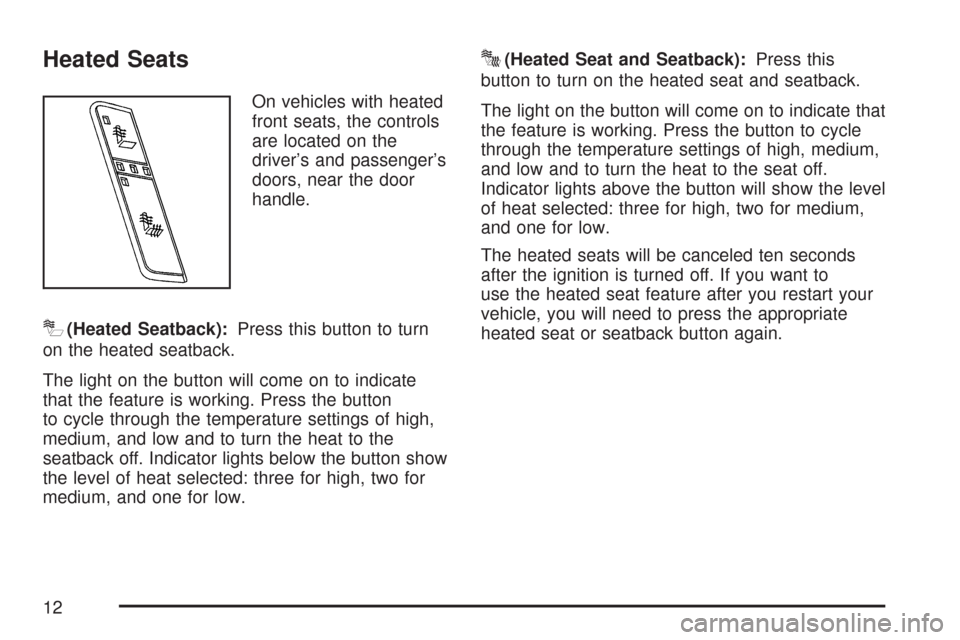
Heated Seats
On vehicles with heated
front seats, the controls
are located on the
driver’s and passenger’s
doors, near the door
handle.
I(Heated Seatback):Press this button to turn
on the heated seatback.
The light on the button will come on to indicate
that the feature is working. Press the button
to cycle through the temperature settings of high,
medium, and low and to turn the heat to the
seatback off. Indicator lights below the button show
the level of heat selected: three for high, two for
medium, and one for low.
J(Heated Seat and Seatback):Press this
button to turn on the heated seat and seatback.
The light on the button will come on to indicate that
the feature is working. Press the button to cycle
through the temperature settings of high, medium,
and low and to turn the heat to the seat off.
Indicator lights above the button will show the level
of heat selected: three for high, two for medium,
and one for low.
The heated seats will be canceled ten seconds
after the ignition is turned off. If you want to
use the heated seat feature after you restart your
vehicle, you will need to press the appropriate
heated seat or seatback button again.
12
Page 14 of 634
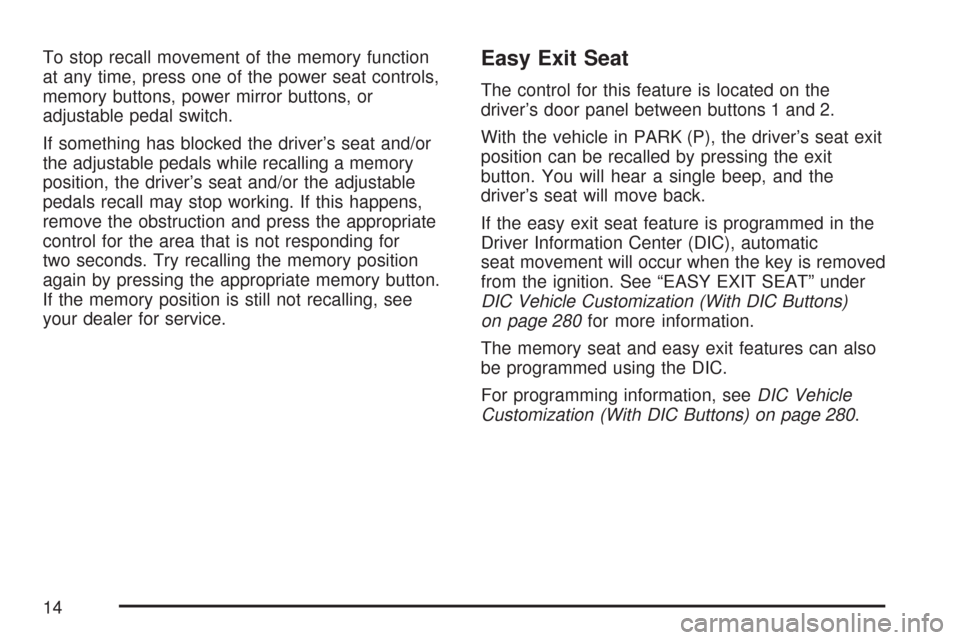
To stop recall movement of the memory function
at any time, press one of the power seat controls,
memory buttons, power mirror buttons, or
adjustable pedal switch.
If something has blocked the driver’s seat and/or
the adjustable pedals while recalling a memory
position, the driver’s seat and/or the adjustable
pedals recall may stop working. If this happens,
remove the obstruction and press the appropriate
control for the area that is not responding for
two seconds. Try recalling the memory position
again by pressing the appropriate memory button.
If the memory position is still not recalling, see
your dealer for service.Easy Exit Seat
The control for this feature is located on the
driver’s door panel between buttons 1 and 2.
With the vehicle in PARK (P), the driver’s seat exit
position can be recalled by pressing the exit
button. You will hear a single beep, and the
driver’s seat will move back.
If the easy exit seat feature is programmed in the
Driver Information Center (DIC), automatic
seat movement will occur when the key is removed
from the ignition. See “EASY EXIT SEAT” under
DIC Vehicle Customization (With DIC Buttons)
on page 280for more information.
The memory seat and easy exit features can also
be programmed using the DIC.
For programming information, seeDIC Vehicle
Customization (With DIC Buttons) on page 280.
14
Page 20 of 634
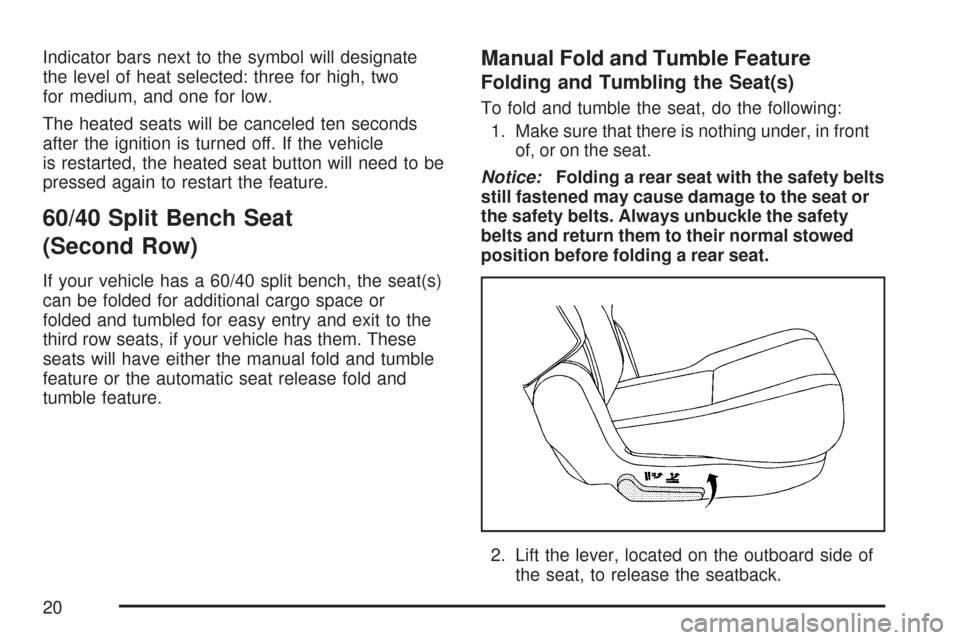
Indicator bars next to the symbol will designate
the level of heat selected: three for high, two
for medium, and one for low.
The heated seats will be canceled ten seconds
after the ignition is turned off. If the vehicle
is restarted, the heated seat button will need to be
pressed again to restart the feature.
60/40 Split Bench Seat
(Second Row)
If your vehicle has a 60/40 split bench, the seat(s)
can be folded for additional cargo space or
folded and tumbled for easy entry and exit to the
third row seats, if your vehicle has them. These
seats will have either the manual fold and tumble
feature or the automatic seat release fold and
tumble feature.
Manual Fold and Tumble Feature
Folding and Tumbling the Seat(s)
To fold and tumble the seat, do the following:
1. Make sure that there is nothing under, in front
of, or on the seat.
Notice:Folding a rear seat with the safety belts
still fastened may cause damage to the seat or
the safety belts. Always unbuckle the safety
belts and return them to their normal stowed
position before folding a rear seat.
2. Lift the lever, located on the outboard side of
the seat, to release the seatback.
20
Page 87 of 634

There is no top tether anchor at the right front
seating position. Do not secure a child seat in this
position if a national or local law requires that
the top tether be anchored or if the instructions
that come with the child restraint say that the top
tether must be anchored. SeeLower Anchors
and Tethers for Children (LATCH) on page 74if
the child restraint has a top tether.
You will be using the lap-shoulder belt to secure
the child restraint in this position. Be sure to follow
the instructions that came with the child restraint.
Secure the child in the child restraint when and as
the instructions say.
1. Your vehicle has a right front passenger’s
frontal airbag. SeePassenger Sensing
System on page 101. We recommend that
rear-facing child restraints be secured in a rear
seat, even if the airbag is off. If your child
restraint is forward-facing, move the seat as
far back as it will go before securing the
child restraint in this seat. SeeManual Seats
on page 9orPower Seats on page 10.When the passenger sensing system has
turned off the right front passenger’s frontal
airbag, the off indicator in the passenger
airbag status indicator should light and stay lit
when you turn the ignition to RUN or
START. SeePassenger Airbag Status
Indicator on page 246.
2. Put the child restraint on the seat.
3. Pick up the latch plate, and run the lap and
shoulder portions of the vehicle’s safety belt
through or around the restraint. The child
restraint instructions will show you how.
87
Page 101 of 634
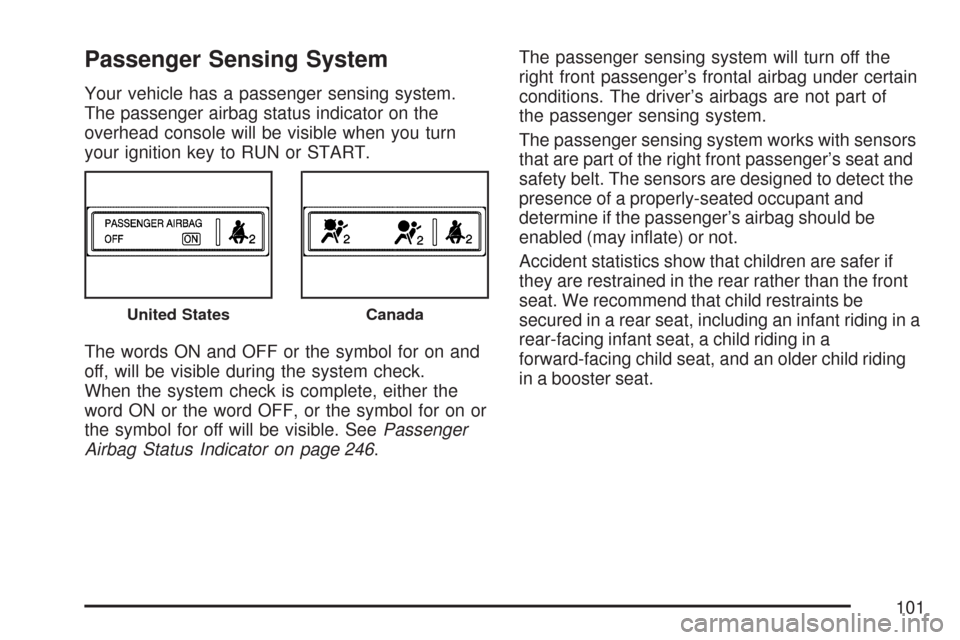
Passenger Sensing System
Your vehicle has a passenger sensing system.
The passenger airbag status indicator on the
overhead console will be visible when you turn
your ignition key to RUN or START.
The words ON and OFF or the symbol for on and
off, will be visible during the system check.
When the system check is complete, either the
word ON or the word OFF, or the symbol for on or
the symbol for off will be visible. SeePassenger
Airbag Status Indicator on page 246.The passenger sensing system will turn off the
right front passenger’s frontal airbag under certain
conditions. The driver’s airbags are not part of
the passenger sensing system.
The passenger sensing system works with sensors
that are part of the right front passenger’s seat and
safety belt. The sensors are designed to detect the
presence of a properly-seated occupant and
determine if the passenger’s airbag should be
enabled (may in�ate) or not.
Accident statistics show that children are safer if
they are restrained in the rear rather than the front
seat. We recommend that child restraints be
secured in a rear seat, including an infant riding in a
rear-facing infant seat, a child riding in a
forward-facing child seat, and an older child riding
in a booster seat.
United StatesCanada
101
Page 106 of 634
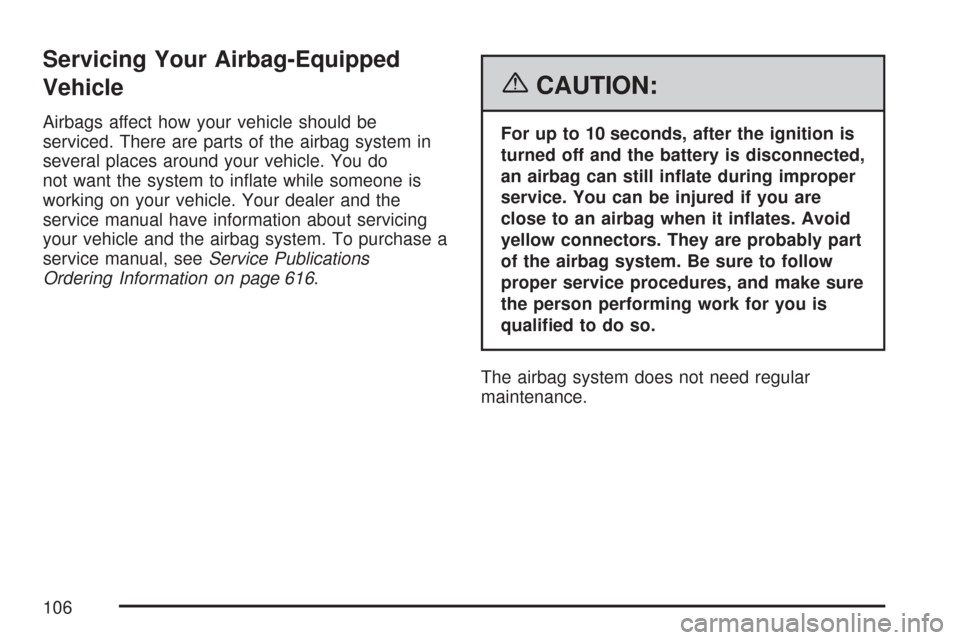
Servicing Your Airbag-Equipped
Vehicle
Airbags affect how your vehicle should be
serviced. There are parts of the airbag system in
several places around your vehicle. You do
not want the system to in�ate while someone is
working on your vehicle. Your dealer and the
service manual have information about servicing
your vehicle and the airbag system. To purchase a
service manual, seeService Publications
Ordering Information on page 616.
{CAUTION:
For up to 10 seconds, after the ignition is
turned off and the battery is disconnected,
an airbag can still in�ate during improper
service. You can be injured if you are
close to an airbag when it in�ates. Avoid
yellow connectors. They are probably part
of the airbag system. Be sure to follow
proper service procedures, and make sure
the person performing work for you is
quali�ed to do so.
The airbag system does not need regular
maintenance.
106
Page 111 of 634
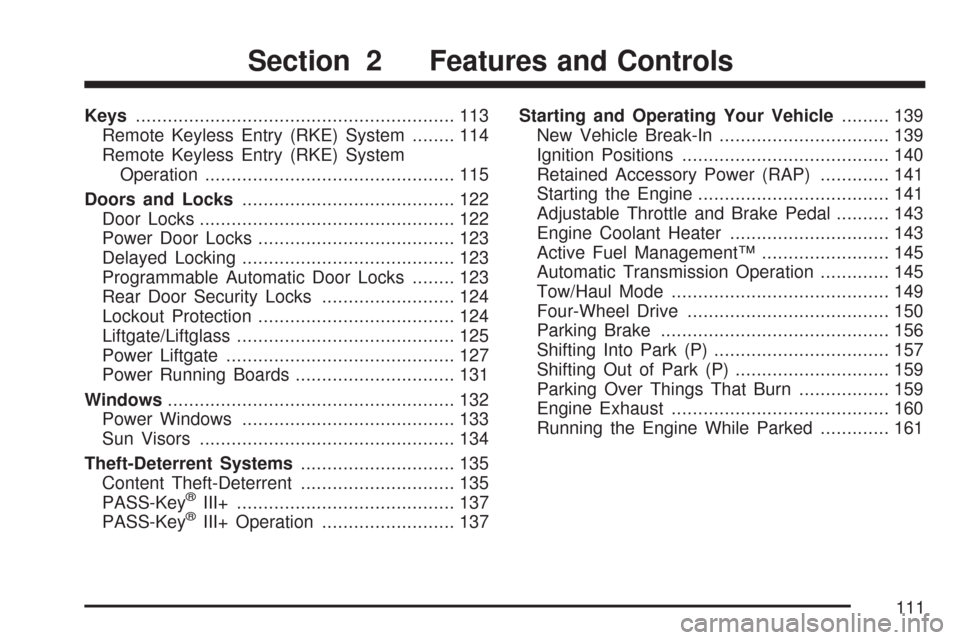
Keys............................................................ 113
Remote Keyless Entry (RKE) System........ 114
Remote Keyless Entry (RKE) System
Operation............................................... 115
Doors and Locks........................................ 122
Door Locks................................................ 122
Power Door Locks..................................... 123
Delayed Locking........................................ 123
Programmable Automatic Door Locks........ 123
Rear Door Security Locks......................... 124
Lockout Protection..................................... 124
Liftgate/Liftglass......................................... 125
Power Liftgate........................................... 127
Power Running Boards.............................. 131
Windows...................................................... 132
Power Windows........................................ 133
Sun Visors................................................ 134
Theft-Deterrent Systems............................. 135
Content Theft-Deterrent............................. 135
PASS-Key
®III+......................................... 137
PASS-Key®III+ Operation......................... 137Starting and Operating Your Vehicle......... 139
New Vehicle Break-In................................ 139
Ignition Positions....................................... 140
Retained Accessory Power (RAP)............. 141
Starting the Engine.................................... 141
Adjustable Throttle and Brake Pedal.......... 143
Engine Coolant Heater.............................. 143
Active Fuel Management™........................ 145
Automatic Transmission Operation............. 145
Tow/Haul Mode......................................... 149
Four-Wheel Drive...................................... 150
Parking Brake........................................... 156
Shifting Into Park (P) ................................. 157
Shifting Out of Park (P)............................. 159
Parking Over Things That Burn................. 159
Engine Exhaust......................................... 160
Running the Engine While Parked............. 161
Section 2 Features and Controls
111
Page 113 of 634
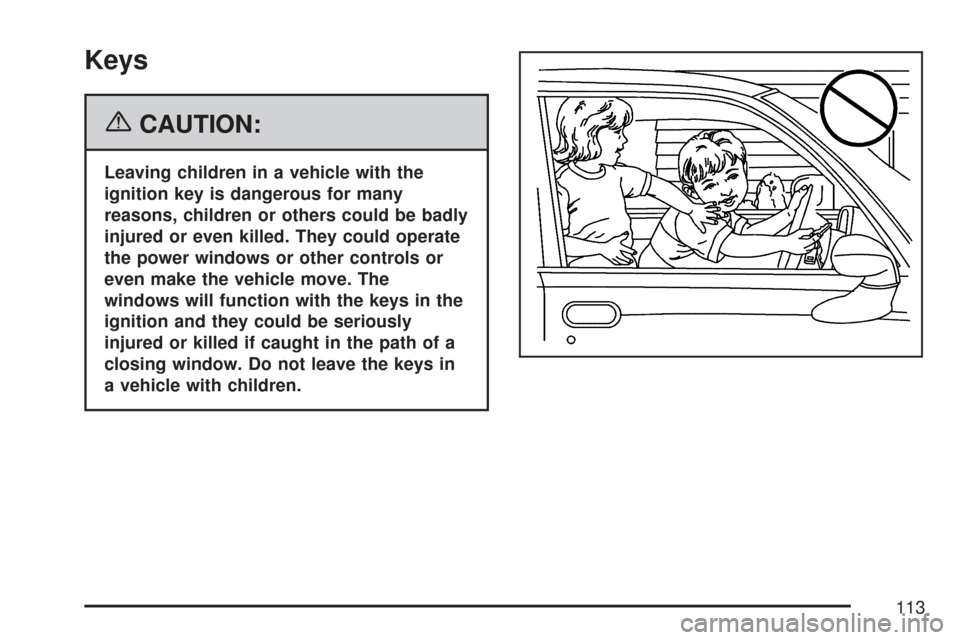
Keys
{CAUTION:
Leaving children in a vehicle with the
ignition key is dangerous for many
reasons, children or others could be badly
injured or even killed. They could operate
the power windows or other controls or
even make the vehicle move. The
windows will function with the keys in the
ignition and they could be seriously
injured or killed if caught in the path of a
closing window. Do not leave the keys in
a vehicle with children.
113
Page 114 of 634
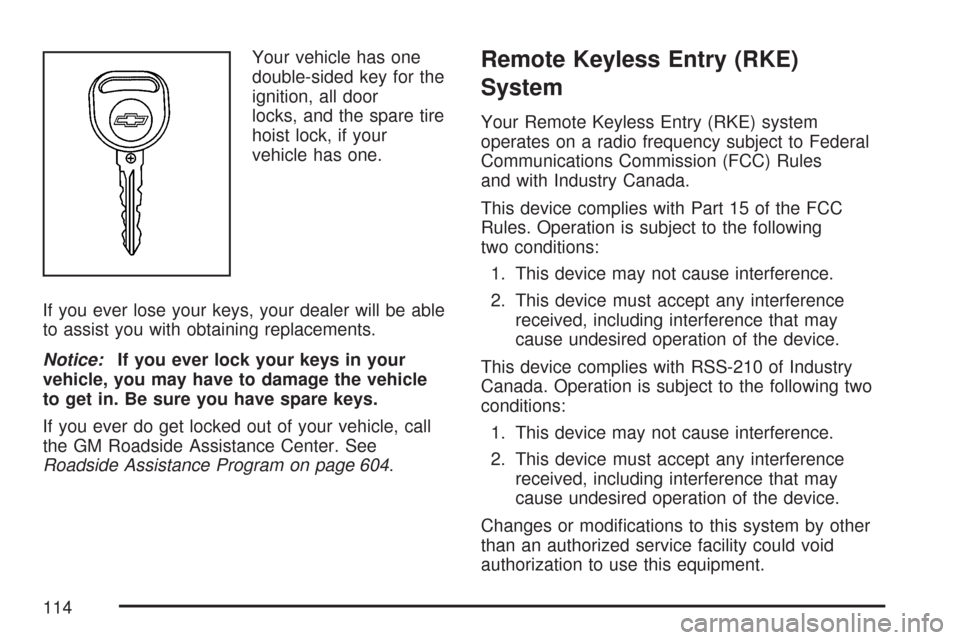
Your vehicle has one
double-sided key for the
ignition, all door
locks, and the spare tire
hoist lock, if your
vehicle has one.
If you ever lose your keys, your dealer will be able
to assist you with obtaining replacements.
Notice:If you ever lock your keys in your
vehicle, you may have to damage the vehicle
to get in. Be sure you have spare keys.
If you ever do get locked out of your vehicle, call
the GM Roadside Assistance Center. See
Roadside Assistance Program on page 604.Remote Keyless Entry (RKE)
System
Your Remote Keyless Entry (RKE) system
operates on a radio frequency subject to Federal
Communications Commission (FCC) Rules
and with Industry Canada.
This device complies with Part 15 of the FCC
Rules. Operation is subject to the following
two conditions:
1. This device may not cause interference.
2. This device must accept any interference
received, including interference that may
cause undesired operation of the device.
This device complies with RSS-210 of Industry
Canada. Operation is subject to the following two
conditions:
1. This device may not cause interference.
2. This device must accept any interference
received, including interference that may
cause undesired operation of the device.
Changes or modi�cations to this system by other
than an authorized service facility could void
authorization to use this equipment.
114
Page 116 of 634
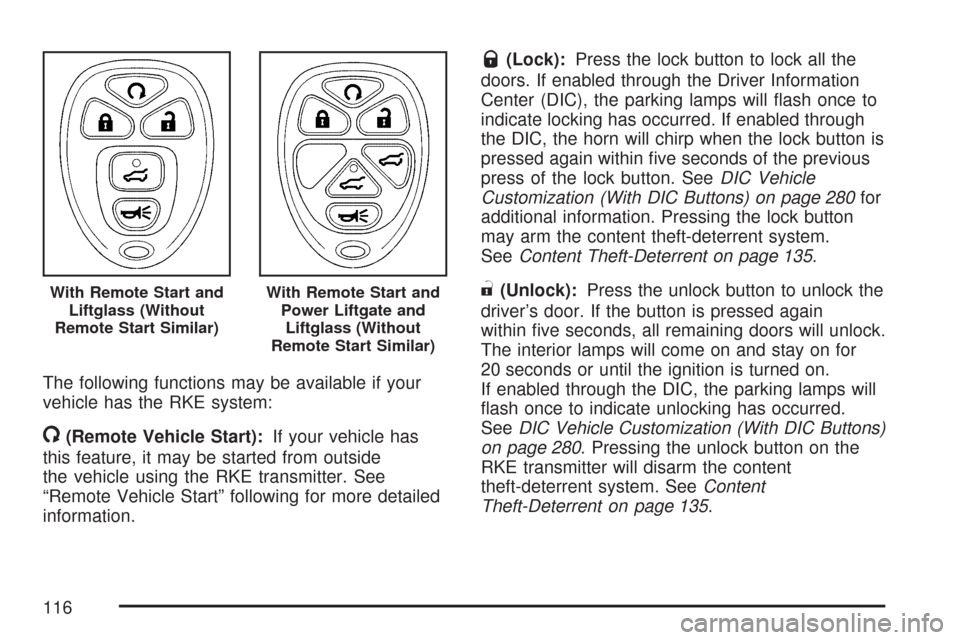
The following functions may be available if your
vehicle has the RKE system:
/(Remote Vehicle Start):If your vehicle has
this feature, it may be started from outside
the vehicle using the RKE transmitter. See
“Remote Vehicle Start” following for more detailed
information.
Q(Lock):Press the lock button to lock all the
doors. If enabled through the Driver Information
Center (DIC), the parking lamps will �ash once to
indicate locking has occurred. If enabled through
the DIC, the horn will chirp when the lock button is
pressed again within �ve seconds of the previous
press of the lock button. SeeDIC Vehicle
Customization (With DIC Buttons) on page 280for
additional information. Pressing the lock button
may arm the content theft-deterrent system.
SeeContent Theft-Deterrent on page 135.
"(Unlock):Press the unlock button to unlock the
driver’s door. If the button is pressed again
within �ve seconds, all remaining doors will unlock.
The interior lamps will come on and stay on for
20 seconds or until the ignition is turned on.
If enabled through the DIC, the parking lamps will
�ash once to indicate unlocking has occurred.
SeeDIC Vehicle Customization (With DIC Buttons)
on page 280. Pressing the unlock button on the
RKE transmitter will disarm the content
theft-deterrent system. SeeContent
Theft-Deterrent on page 135.With Remote Start and
Liftglass (Without
Remote Start Similar)With Remote Start and
Power Liftgate and
Liftglass (Without
Remote Start Similar)
116